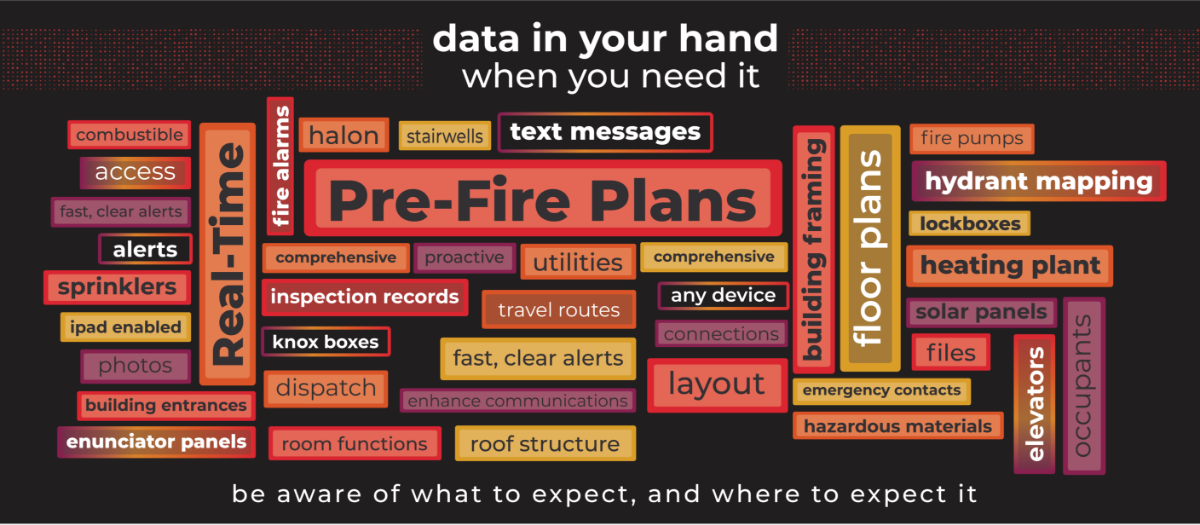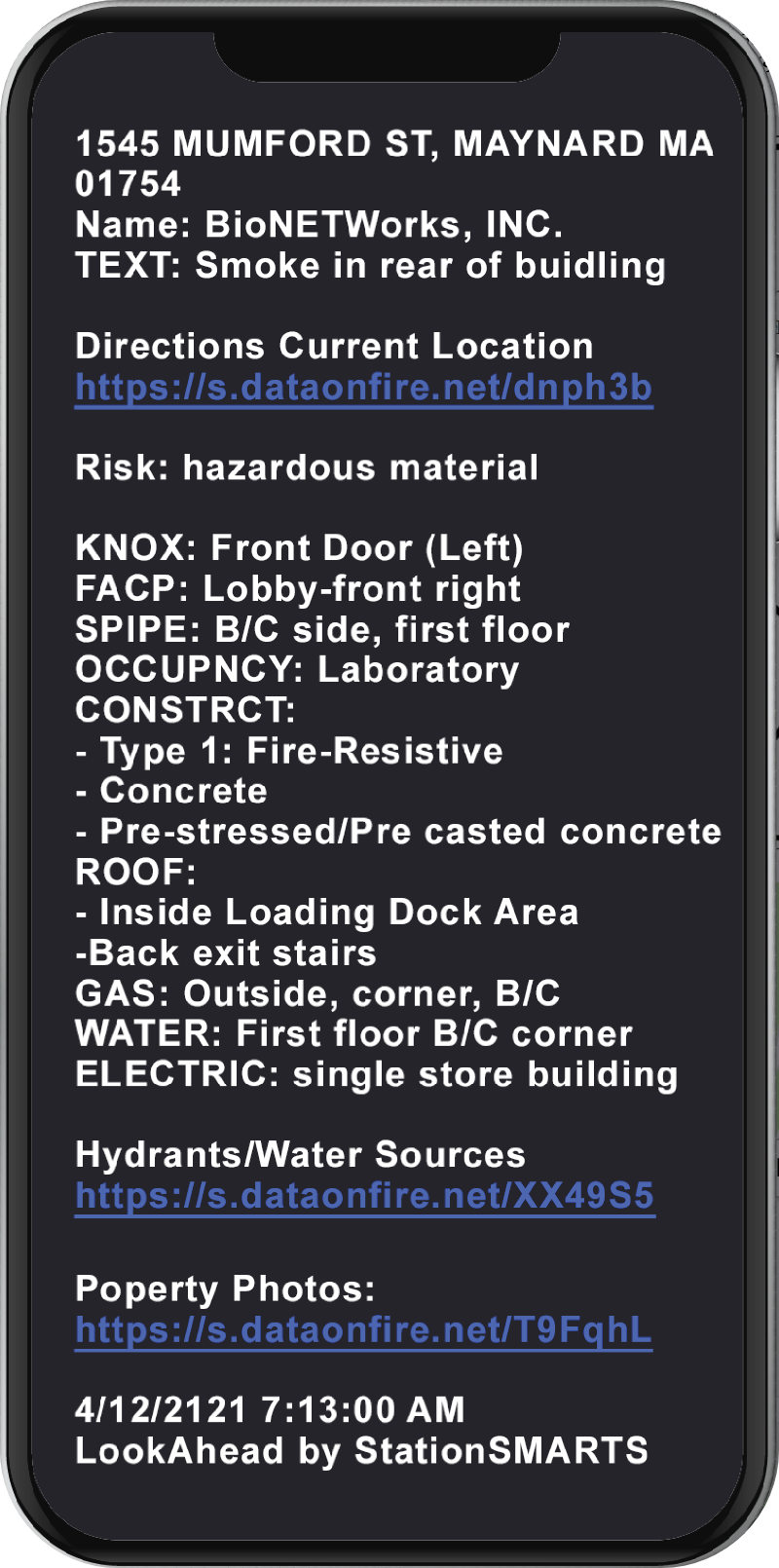Pre-Fire Plans
stationSMARTS proprietary “Look Ahead” Situational Awareness

An advanced and effective
checklist approach to conducting pre-plans
checklist approach to conducting pre-plans
First responders are well aware of the importance of Situational Awareness. stationSMARTS takes pre-incident planing to the next level – valuable pre-fire plan data is no longer stored in a file cabinet or three-ring binder, inaccessible when you most need it. It is now readily on-hand, incorporated into the run alert itself and pushed to any and all mobile devices.
stationSMARTS pre-plan data is made accessible to the crews in-route and in the field at the time of response in a format where the critical information is easily accessible, is site specific and can be viewed and assessed in a matter of seconds. For example, the location of Knox Boxes, knowledge of obstacles such as solar panels and hazardous combustible materials must be at the forefront of the alert while historical building inspections and code violations must be accessible when needed.
With a web browser pre-plans along with hydrant maps can easily be shared with multiple agencies so mutual aid partners have quick access to maps showing in-service and out-of-service hydrants and up-to-date site specific pre-plan data.
Pre-Incident Planning
For many fire departments, first responders arrive on scene without any pre-fire data. stationSmarts changes that.
A number of factors work against responders having situational awareness in cases of a response, including: incomplete, inaccurate, or uncertain information, absence of information prioritization with very limited information sharing.
Complicating matters further…
1. ISO compliance can be an impossible challenge.
- If a Chief’s goal is to maximize ISO points, pre-plans must be conducted on each commercial, industrial, institutional and similar types of buildings twice a year.
- ISO dictates inspections should include up-to date notes and include building floor plans.
- Given limited staffing, most Chiefs would consider it unrealistic to conduct twice a year pre-incident plans or for that matter to conduct these surveys even once a year.
- In reality, updated pre-plans for required structures – in most fire departments’ communities – occur typically once every three to five years.
2. The NFPA 1620 standard for data availability:
- Pre-Incident information be must be accessibility to all staff on all apparatus.
- Specifies the minimum information that needs to be part of a pre-incident fire plan, which includes a building’s occupancy and use, architecture and design, safety features and equipment, surrounding buildings, entrances and exits, and contact information of managing staff.
IDEALLY DATA SHOULD BE:
- Collected on every commercial structure
- Immediately available at, and prior to, the time of response
- Formatted so personnel can assess it quickly
stationSMARTS has taken extensive efforts to ensure that every responder has access to the building’s information regardless of arrival time, rank, or job description.
The assembling of a pre-plan inspection starts with the collection of visual information, documents and photos on a walk-through. We help achieve these process with a windows tablet or iPad enabled pre-incident check lists.
With stationSMARTS pre-plan application responding crews have critical information in their hands, just when they need it.
With our pre-plan site survey checklists and our just-in-time text alerting – we push easy-to-read, critical run data to mobile devices.
- Enable and Support Conducting Site Surveys: for office buildings, strip malls, industrial buildings, high rises, complexes and campuses. Our intuitive tablet checklist documents key data in an easy-to-use format that is quickly assessable to help manage an incident.
- Comprehensive Decision Support: Personnel have instant access to critical pre-planning information such as building structure, diagrams, maps, hazardous materials, occupancy type, managment staff and working hydrants.
Easy to Learn and Use Features
- Users can easily edit pre-plans on mobile devices
- Google Maps and street view are supported
- Pre-plan data gathering is formatted as intuitive checklists
- Add custom map markers through the user interface
- Access photos and attachments at the time of response
- Users can access data as a text on all phones, iPads and tablets
- Auto-address matching, pre-plan is automatically tied to a call
- Users can easily add attachments and photos to an occupancy
- Includes history tracking of pre-plans with audit logs
- Pre-plans include an array of details include the location and specs of critical items such as:
- building framing, structure floor plans, along with building framing, construction type, heating plant and utility cutoffs, stairwells, elevators and
- lockboxes, access routes into a building or complex
- enunciator panels, automatic system controls, standpipes and sprinklers, location and type of any fire pumps, the type and capacity of automatic sprinkler systems, standpipe connections, fire alarm systems, and special hazard protection systems
- a list of hazardous materials in the building
- occupancy, up-to-date emergency contact information such as property owners, tenants and business managers
- photos of building
- history of any inspections and code violations
- A flexible built-in windshield survey tool for the recording of target hazards, enables the department to generate detailed reports identifying and ranking hazardous and commercial sites throughout the community

Share Pre-plans with
Mutual Aid Partners
Mutual Aid Partners
Designate to whom and when pre-plan alerts are issued
Pre-plans are accessible in an instant, virtually on any device and deliver critical data to the individual first responder for that run. stationSMARTS texting can ensure relevant data is easily within reach of any responder – ideally pulling up a pre-incident plan as easily as receiving a text message.
- Alerts can be pushed to any mobile device: tablets, phones and iPads.
- Delivery is easily configurable: by shift, staff member, position title, type of run and time of day.
- Staff have the option to choose how and when they want to be notified of runs with pre-plans
- You can adjust these settings specifically for your operation. For example get notified for fires from 7am to 7pm; Run notifications except rescue, turn off all alerts for ambulance runs.
- You can set your department’s duty status for automating call alerts delivery. You will not get alerts if your status is set to Off Duty. Admins are also able to set-up filters based on groups or call type ensuring alerts are relevant and to minimizing alert fatigue.
- The software includes pre-plan management tools that allows system admins to change pre-plan cycles, assign pre-plans and develop a ranking of all community target hazards.













